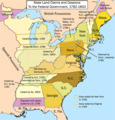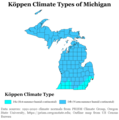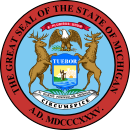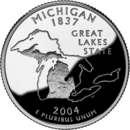Portal:Michigan
The Michigan Portal  Michigan (/ˈmɪʃɪɡən/ MISH-ig-ən) is a state in the Great Lakes region of the Upper Midwest region of the United States. It borders Wisconsin to the northwest in the Upper Peninsula, and Indiana and Ohio to the south in the Lower Peninsula; it is also connected by Lakes Superior, Michigan, Huron, and Erie to Minnesota and Illinois, and the Canadian province of Ontario. With a population of nearly 10.12 million and an area of 96,716 sq mi (250,490 km2), Michigan is the 10th-largest state by population, the 11th-largest by area, and the largest by area east of the Mississippi River. Its capital is Lansing, and its largest city is Detroit. Metro Detroit is among the nation's most populous and largest metropolitan economies. The name derives from a gallicized variant of the original Ojibwe word ᒥᓯᑲᒥ (mishigami), meaning "large water" or "large lake". Michigan consists of two peninsulas. The Lower Peninsula resembles the shape of a mitten, and comprises a majority of the state's land area. The Upper Peninsula (often called "the U.P.") is separated from the Lower Peninsula by the Straits of Mackinac, a five-mile (8 km) channel that joins Lake Huron to Lake Michigan. The Mackinac Bridge connects the peninsulas. Michigan has the longest freshwater coastline of any political subdivision in the United States, being bordered by four of the five Great Lakes and Lake St. Clair. It also has 64,980 inland lakes and ponds. Michigan has the second-most water area of any state, behind only Alaska. The area was first occupied by a succession of Native American tribes over thousands of years. In the 17th century, French explorers claimed it as part of the New France colony, when it was largely inhabited by Indigenous peoples. French and Canadian traders and settlers, Métis, and others migrated to the area, settling largely along the waterways. After France's defeat in the French and Indian War in 1762, the region came under British rule. Britain ceded the territory to the newly independent United States after its defeat in the American Revolutionary War. The area was part of the larger Northwest Territory until 1800, when western Michigan became part of the Indiana Territory. Michigan Territory was formed in 1805, but some of the northern border with Canada was not agreed upon until after the War of 1812. Michigan was admitted into the Union in 1837 as the 26th state, a free one. It soon became an important center of industry and trade in the Great Lakes region, attracting immigrants in the late 19th and early 20th centuries from many European countries. Immigrants from Finland, Macedonia, and the Netherlands were especially numerous. Migration from Appalachia and of Black Southerners as part of the Great Migration increased in the 1930s, with many settling in Metro Detroit. Although Michigan has developed a diverse economy, in the early 20th century it became widely known as the center of the U.S. automotive industry, which developed as a major national economic force. It is home to the country's three major automobile companies (whose headquarters are all in Metro Detroit). Once exploited for logging and mining, today the sparsely populated Upper Peninsula is important for tourism because of its abundance of natural resources. The Lower Peninsula is a center of manufacturing, forestry, agriculture, services, and high-tech industry. (Full article...) Entries here consist of Good and Featured articles, which meet a core set of high editorial standards.
Sparty is the mascot of Michigan State University. Sparty is usually depicted as a muscular male Spartan warrior/athlete dressed in stylized Greek costume. After changing the team name from "Aggies" to "Spartans" in 1925, various incarnations of a Spartan warrior with a prominent chin appeared at university events and in university literature. In 1943, MSU art professor Leonard D. Jungwirth designed a statue for the university, which had to be cast in terra cotta because of World War II rationing. In 2005, the university replaced Jungwirth's original statue with a bronze replica, moving the original indoors to protect it from the elements. Sparty appears in several other incarnations. In printed literature, the university uses a copyrighted cartoon Spartan, usually drawn with a grimace and several days worth of whiskers, lending the nickname of "Gruff" Sparty. Finally, Sparty appears as a foam rubber mascot with an oversized head. The mascot costume, worn by an anonymous student, appears at most university sporting, alumni, and fundraising events; he is often portrayed in MSU notices and materials. (Full article...)Selected picture -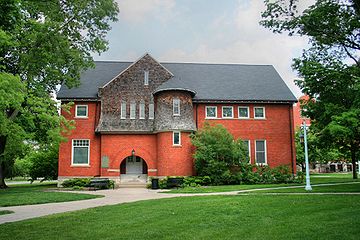 Eustace-Cole Hall (formerly Harry J. Eustace Hall, formerly Horticultural Laboratory) is a structure on the campus of Michigan State University. Eustace-Cole is the only building on MSU's main campus that is on the National Register of Historic Places. Did you know -
Related portalsSelected article -Turtle Island is a 1.5-acre (0.61 ha) island in the western portion of Lake Erie in the United States. The island is divided between the U.S. states of Michigan and Ohio. Turtle Island is located about five miles (8.0 km) northeast of the mouth of the Maumee River in Maumee Bay. Today, the island houses several abandoned structures and the ruins of Turtle Island Light, a lighthouse dating back to 1866. According to the Census Bureau, most of the island physically lies in Jerusalem Township in Lucas County, Ohio with the smaller Michigan portion being part of Erie Township in Monroe County, Michigan. It was sold in 1995, and there was a failed housing project in the early 2000s, and it was sold again 2022 in private ownership. The island has been eroded by Lake Erie, and the lighthouse damaged by winter storms and it is one of the most endangered lighthouses in the nation. The island was once over 6 acres in the 19th century, but is now less then an acre. It is the only sand and gravel island in the whole lake, and is more vulnerable, and there is periodic efforts to try to rebuild the island and save the lighthouse and make a park area. (Full article...)Selected biography -Adolph George "Germany" Schulz (April 19, 1883 – April 14, 1951) was an All-American American football center for the University of Michigan Wolverines from 1904 to 1905 and from 1907 to 1908. While playing at Michigan, Schulz is credited with having invented the spiral snap and with developing the practice of standing behind the defensive line. As the first lineman to play in back of the line on defense, he is credited as football's first linebacker. During his time at Michigan, Schulz also became involved in one of college football's earliest recruiting controversies, as some suggested that he was a "ringer" recruited by Michigan coach Fielding H. Yost. Schulz was 21 years old when he enrolled at Michigan and had worked in an Indiana steel mill and reportedly played for either amateur or professional teams. Michigan was refused re-entry into the Western Conference in 1908 when it insisted on playing the 25-year-old Schulz for a fourth season in violation of conference eligibility rules. (Full article...)General imagesThe following are images from various Michigan-related articles on Wikipedia.
TopicsCategoriesSymbols
Lists
Related pagesWikimediaThe following Wikimedia Foundation sister projects provide more on this subject:
Things you can doDiscover Wikipedia using portals | ||||||||||||||||||||||||||||||||||||







